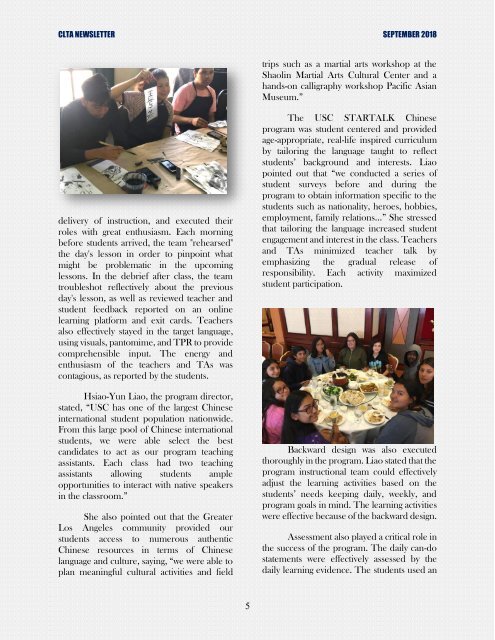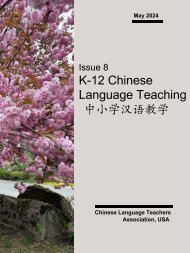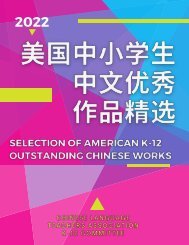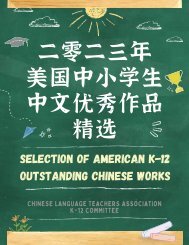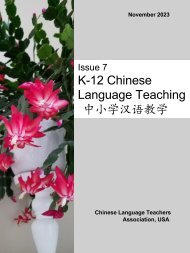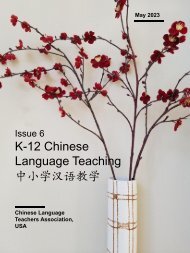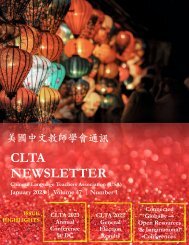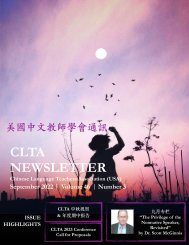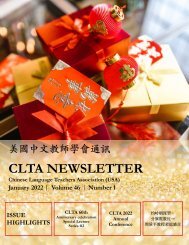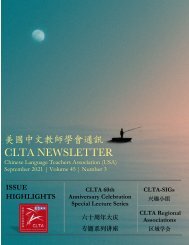CLTA newsletter Sept 2018
Create successful ePaper yourself
Turn your PDF publications into a flip-book with our unique Google optimized e-Paper software.
<strong>CLTA</strong> NEWSLETTER SEPTEMBER <strong>2018</strong><br />
trips such as a martial arts workshop at the<br />
Shaolin Martial Arts Cultural Center and a<br />
hands-on calligraphy workshop Pacific Asian<br />
Museum.”<br />
delivery of instruction, and executed their<br />
roles with great enthusiasm. Each morning<br />
before students arrived, the team "rehearsed"<br />
the day's lesson in order to pinpoint what<br />
might be problematic in the upcoming<br />
lessons. In the debrief after class, the team<br />
troubleshot reflectively about the previous<br />
day's lesson, as well as reviewed teacher and<br />
student feedback reported on an online<br />
learning platform and exit cards. Teachers<br />
also effectively stayed in the target language,<br />
using visuals, pantomime, and TPR to provide<br />
comprehensible input. The energy and<br />
enthusiasm of the teachers and TAs was<br />
contagious, as reported by the students.<br />
Hsiao-Yun Liao, the program director,<br />
stated, “USC has one of the largest Chinese<br />
international student population nationwide.<br />
From this large pool of Chinese international<br />
students, we were able select the best<br />
candidates to act as our program teaching<br />
assistants. Each class had two teaching<br />
assistants allowing students ample<br />
opportunities to interact with native speakers<br />
in the classroom.”<br />
She also pointed out that the Greater<br />
Los Angeles community provided our<br />
students access to numerous authentic<br />
Chinese resources in terms of Chinese<br />
language and culture, saying, “we were able to<br />
plan meaningful cultural activities and field<br />
The USC STARTALK Chinese<br />
program was student centered and provided<br />
age-appropriate, real-life inspired curriculum<br />
by tailoring the language taught to reflect<br />
students’ background and interests. Liao<br />
pointed out that “we conducted a series of<br />
student surveys before and during the<br />
program to obtain information specific to the<br />
students such as nationality, heroes, hobbies,<br />
employment, family relations...” She stressed<br />
that tailoring the language increased student<br />
engagement and interest in the class. Teachers<br />
and TAs minimized teacher talk by<br />
emphasizing the gradual release of<br />
responsibility. Each activity maximized<br />
student participation.<br />
Backward design was also executed<br />
thoroughly in the program. Liao stated that the<br />
program instructional team could effectively<br />
adjust the learning activities based on the<br />
students’ needs keeping daily, weekly, and<br />
program goals in mind. The learning activities<br />
were effective because of the backward design.<br />
Assessment also played a critical role in<br />
the success of the program. The daily can-do<br />
statements were effectively assessed by the<br />
daily learning evidence. The students used an<br />
5


